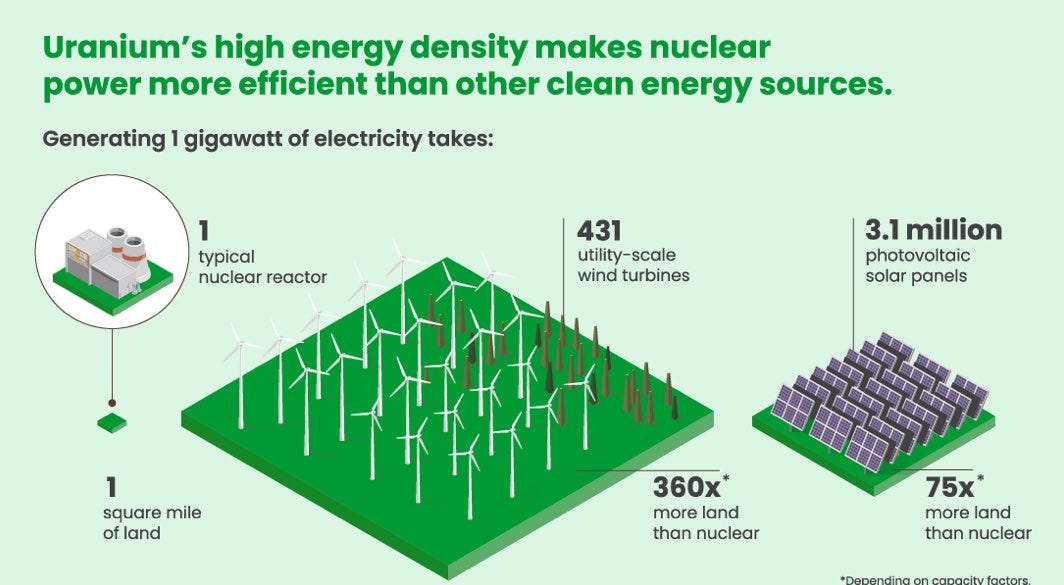Hello, and pardon my absence these last couple of weeks! I’ll have several posts about my European travels starting Friday, but wanted to reposting some recent IWF/IWV blogs and articles you might have missed from me.
Next up: My IWF blog explaining excitement over America’s nuclear renaissance.
A nuclear energy renaissance is on the horizon here in the U.S.
Nuclear operates almost 24/7 and works 93% of the year, while being responsible for 18.6% of utility-scale electricity generation. Facilities boast a small environmental footprint—typically requiring one square mile for a single plant producing 1 gigawatt (GW) of electricity. Solar and wind, in contrast, use 75 and 360 times more land, respectively, to generate the same amount of electricity. And it was the U.S. that pioneered this technology in the 1940s through the first operating nuclear reactor at the University of Chicago.
A growing share of Americans across partisan lines support expanding our nuclear power capacities. An August 2024 Pew Research poll found that 56% of respondents would like to see more nuclear reactors constructed here in the U.S. This is largely driven by alarm with adversaries like China and Russia approving more facilities.
After a summer that saw the completion of Georgia Power Vogtle Nuclear Plant and President Biden signing the ADVANCE Act into law, three major developments suggest our country is getting serious about deploying this clean energy source.
#1. Energy Dept Releases Report Showing Potential for 60GW of New Nuclear Power
On September 9th, 2024, the Department of Energy released an extensive report identifying 60 GW of potential new sources of nuclear power across 41 operating or recently retired plants.
The report, “Evaluation of Nuclear Power Plant and Coal Power Plant Sites for New Nuclear Capacity,” thoroughly examined all 54 existing and 11 retired nuclear plants across 31 U.S. states. These facilities were evaluated based on “availability of adequate cooling water, proximity to large population centers or hazardous facilities, or unacceptable seismic or flood hazards.”
The excitement over the recent completion of the Vogtle Plant in Georgia and Tennessee being selected for a new uranium enrichment site has given way to more nuclear reactors, including Three Mile Island, to come back online.
“If you purport to be an environmentalist or conservationist, supporting nuclear is a no-brainer, “ I wrote on Twitter.
#2. Three Mile Island Nuclear Reactor Brought Back to Life
The energy industry, lawmakers, and social media lit up with excitement over the September 20th announcement of the Three Mile Island Nuclear Station in Middletown, Pennsylvania, coming back to life, just five years after closing, to power Microsoft AI-powered data centers.
The deal brokered between TMI’s owner, Constellation Energy, and Microsoft will last 20 years and commence in 2028, pending approval. The rebranded Crane Clean Energy Center will occupy Unit 1 and is forecasted to pump back $16 billion in the Keystone State’s economy and create 3,400 indirect and direct jobs.
Shortly after the deal was announced, Pennsylvania Governor Josh Shapiro urged PJM Interconnection—the regional transmission organization (RTO) coordinating the movement of electricity in 13 states, including his, and D.C.—to fast-track the plan.
“Given the lengthy review process for new projects, it is imperative that shovel-ready resources like the Crane Clean Energy Center be allowed to come online as quickly as possible rather than waiting in the [interconnection] queue as if they were an entirely new development,” Shapiro wrote in a letter.
Although the 1979 TMI accident was the worst nuclear incident in U.S. history, the Nuclear Regulatory Commission (NRC) demystified misinformation surrounding the meltdown of Unit 2. It explained, “Small radioactive releases had no detectable health effects on plant workers or the public” but resulted in improvements to emergency response planning, operator training, and enhanced overall nuclear energy safety.”
Commonwealth Foundation’s André Béliveau applauded the deal and recommended more private investment—not government interference—to supercharge these projects. He explained:
Private industry knows the need for reliable energy sources to keep the grid online for the new wave of data centers powering our ever-advancing technology needs. Current progressive policy trends toward a government-forced transition away from reliable energy and advocates for handouts to achieve it. These programs—such as the Inflation Reduction Act and Gov. Josh Shapiro’s proposed Pennsylvania Reliable Energy Sustainability Standard (PRESS)—disrupt price signals in our energy markets and flood them with unreliable, weather-dependent sources. Most importantly, such government programs force ratepayers to pay more for less reliable energy, threaten high-paying jobs, and arbitrarily close reliable power plants without replacements.
Due to this blockbuster TMI deal, major financial institutions want to bank on the excitement over potential nuclear energy investments—due to intermittent renewables being unable to meet future U.S. electricity demand.
#3. Financial Institutions Eager to Bank on Nuclear Energy
Financial asset managers had an aversion to nuclear energy investments, but appear to be reconsidering this position in wake of the $16 billion Three Mile Island deal.
Financial Times reported 14 global banks and financial institutions—including Bank of America, Barclays, BNP Paribas, Citi, Morgan Stanley, and Goldman Sachs—are eager to support nuclear energy, with the hope the industry “will unlock finance for a new wave of nuclear power plants.” These institutions are aligning their goals with a campaign to triple the nuclear energy supply by 2050.
Banks cite “the difficulty and high cost of financing nuclear projects” as the reasons behind the slowdown of construction in the last 50 years.
It’s also expected banks will encourage nuclear investments so financial institutions can meet their environmental, social, and governance (ESG) pledges to achieve carbon neutrality by 2050.
Morningstar suggested the best nuclear-friendly stocks and funds are TC Energy, Public Service Enterprise Group, and Constellation (which owns TMI).
Conclusion
Our Center for Energy and Conservation supports sensible nuclear reforms and projects that boost our electricity supply, foster job creation, and balance development with environmental stewardship.
The revitalization of nuclear energy in America is noteworthy, yet it shouldn’t be lumped into net-zero climate goals.
Federal directives urging the U.S. economy to be fully rid of fossil fuels by 2050 have been doomed by relying on utility-scale solar and wind—nonviable alternatives. An estimated $1.8 trillion in subsidies, across a decade, is expected to be allocated towards the Biden-Harris administration’s preferred clean energy projects—namely wind, solar, and electric vehicles. The problem is these projects are unlikely to be profitable or fully operational.
Nuclear can’t face a similar fate. That’s why permitting reform, deregulation, and inviting market innovation in this space must be top of mind for regulators and lawmakers if they desire to unleash nuclear power capabilities here in the U.S.
To learn more about nuclear energy, go HERE.






